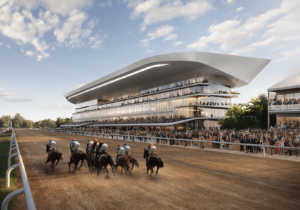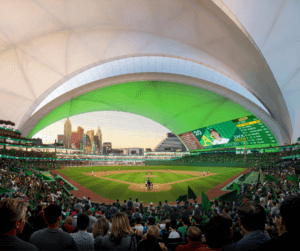In many ways, it’s fitting that a team who was the world’s first all-vegan soccer club and has the word “Forest” in their name should play in a stadium made entirely of wood. That is about to become a reality for U.K. hipster soccer minnows (think minor league) Forest Green Rovers from the sleepy town of Nailsworth, Gloucestershire in West England thanks to Zaha Hadid Architects’ (ZHA) all-timber design.
Their current stadium called “The New Lawn” (a name born when terracing was added in the 1950s; previously the “stadium” was merely just a lawn and named accordingly as “The Lawn”) can be found on a road called Another Way. And another way is on the horizon. While one yearns for ZHA’s design to be called “The New New Lawn,” the stadium will predictably be known as “Eco Park Stadium”—perhaps an unsurprising choice in the age of stadia bearing their financier’s namesake, which in this case is local green energy firm, Ecotricity.
The stadium will be the focal point of the $124 million “Eco Park” development which comprises 100 acres worth of space dedicated to sports and green technology. Alongside the stadium, grass and all-weather training pitches, publicly accessible multi-disciplinary facilities, and a sports science hub will form one-half of the site. Meanwhile, a green technology business park, housing commercial offices and light industrial units, will form the other. Ecotricity’s proposal also includes work being done on the site’s nature reserve and the nearby Stroudwater canal as well as the potential addition of a public transport hub. While the prime stadium naming opportunity was passed up, hopes of the stadium being placed on a road within the development called “The Other Way,” or at least something that references the team’s quirkily-named origins, remain un-dashed.
As for ZHA’s design, the structure will be first all-timber stadium in the world. The typically undulating Hadid style can be seen in the stadium’s roof design. Such a style, however, is not uncommon in contemporary stadia where similarly curving roofscapes are used as acoustic devices to contain crowd noise. Since the devastating Bradford City FC stadium fire of 1985, timber has been largely ignored as a material for stadium design, especially in the realm of British soccer despite advancements in fire retardant treatments.
The stadium will have a capacity of 5,000. Forest Green Rovers’ current home ground actually offers room for 5,140 though only 2,000 of this is seated. The team has never been a member of the professional Football League in the U.K., but has made exceptionally steady progress (40 years without any relegations) from floundering in unheard of Hellenic Football League Premier Division to the Conference National League–one tier away from prized professional football where the minimum capacity requirement stands at 5,000.
Club Chairman Dale Vince has green-fingered ambition. He has been turning the club into one the most eco-friendly soccer teams around since he became a major shareholder in 2010. Since then, numerous solar panels have been installed on the team’s current stadium while an organic soccer pitch (another world-first) is kept trim by a solar-powered robot grass mower. However, in terms of soccer, at their current rate of progression, the dizzying heights of the Premier League is only 68 years away.
“The club’s heritage, ambition, and vision reflect our own, combining the latest material research and construction techniques with new design approaches to build a more ecologically sustainable and inclusive architecture,” said Director at ZAH, Jim Heverin. “With the team’s community and supporters at its core, fans will be as close as five meters from the pitch and every seat has been calculated to provide unrestricted sightlines to the entire field of play. The stadium’s continuous spectator bowl surrounding the pitch will maximize matchday atmosphere.”
A stadium solely designed for soccer playing will also be welcome news for fans. As London club West Ham United recently found out, multipurpose stadia–often with seating miles away from the pitch–are bereft of atmosphere. As a result, one expert has called for the former Olympic Park stadium to be knocked down. A successful precedent, though, for bespoke soccer-orientated stadia can be seen in Herzog & de Meuron’s Allianz Arena for Bayern Munich in Germany where crown proximity, circulation, and acoustics are at the forefront of the design.
ZHA’s design also follows in Herzog & de Meuron’s footsteps in its use of an unconventional material for a stadium—a phenomenon which appears be on the rise for the U.K. soccer typology. Herzog and de Meuron’s bold brick design for Chelsea FC also strays away from the explicitly tectonic approach almost always donned by stadia in the recent past. This style is even more prevalent in the U.K. in the wake of the Taylor Report whereby stadium safety was once hot on the agenda and thus expressed aesthetically.










